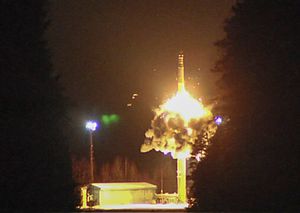Thursday, the Russian military test fired four intercontinental-range ballistic missiles (ICBM) as part of a routine exercise of the Russian strategic nuclear forces, the Russian Ministry of Defense (MoD) said in an October 26 statement.
“A squad of the Strategic Missile Force fired a Topol intercontinental ballistic missile from Plesetsk towards the Kura test range in Kamchatka,” the MoD said. The missile was launched from a road-mobile transporter erector launcher. The Plesetsk space center is located in Arkhangelsk Oblast, approximately 800 kilometers north of Moscow.
In addition, “a nuclear submarine of the Pacific Fleet carried out a salvo launch of two ballistic missiles from the Sea of Okhotsk towards the Chizha testing range in the Arkhangelsk region,” the MoD said. “A nuclear submarine of the North Fleet fired a ballistic missile from the Barents Sea towards Kura.”
The military exercise also involved supersonic Tupolev-160, Tupolev-85MS and Tupolev-22MZ strategic bombers. The aircraft launched cruise missiles at ground targets at Kura, Pemboi testing range in the northeastern region of Komi, and Terekta in Kazakhstan, according to the MoD.
All missiles reportedly hit their practice targets. Save the Topol-M, the Russian MoD did not reveal the type of missiles fired from the air and sea. It also did not specify the class of ballistic missile submarines involved in the drill.
The missiles launched from the strategic bombers were likely Kh-101/Kh-102 (the nuclear variant of the Kh-101) air-launched cruise missiles with an estimated range of 2,700 to 5,000 kilometers (1677 to 3,100 miles).
The submarines involved in the exercise are most likely Soviet-era Project 667BDR Kal’mar (Squid) Delta-III , Project 667 BDRM Delta IV-class nuclear-powered ballistic missile submarines (SSBN) armed with the R-29R/R-2S (NATO reporting name: SS-N-18 Stingray) ICBM, or Project 955 Borei-class (“North Wind”) aka Dolgoruky-class SSBNs armed with the Bulava (RSM-56) ICBM — a sea-based variant of the Topol-M — —capable of carrying up to ten warheads.
The Borei-class of SSBNs is slated to replace Project 941 Typhoon-class and Delta-class SSBNs in the next few years as these older boats are slowly getting retired. The Russian Navy has also been working on an improved variant of the Project 955 Borei-class, the Project 955A Borei II-class, which will be capable of carrying up to 20 Bulava ICBMs rather than the 16 carried aboard the original Borei-class.
The only ICBM identified by name in the press release is the nuclear-capable Topol-M (aka RS12M2/NATO reporting name: SS-27), a three-stage solid fueled ICBM with a reported maximum range of 11,000 kilometers (6,835 miles). The missile can carry a single 550-kiloton nuclear-tipped warhead. It can also be upgraded to carry independently targetable warheads. As I explained earlier this year:
Russia has (…) been developing an upgraded Topol-M variant, the more advanced Topol MR (aka SR-24 Yars/NATO reporting name: SS-27 Mod2) first revealed in 2010. The Yars, reportedly fitted with more advanced decoys and countermeasures than the Topol-M and featuring a higher speed, has been specifically designed to evade Western anti-ballistic missile defense systems.
The Topol-M was last test fired in September.

































